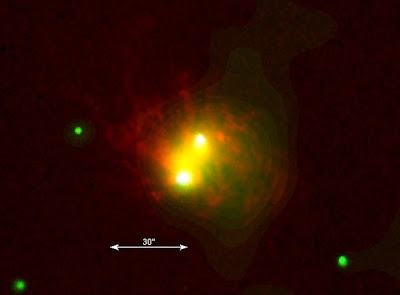Work in progress: The unusual starbursting dwarf galaxy NGC 3125

The above image is from an ongoing (*) project I have to study the energy loss via X-ray emission in the dwarf starburst galaxy NGC 3125. This is a representative color image where red is optical H-alpha emission (warm ionized gas at T ~ 104 K), green is soft X-ray emission (E=0.3-2 keV, temperature T ~ a few times 106 K for the diffuse X-ray-emitting gas) and blue is hard X-ray emission (E=2-8 keV, non-thermal emission). The X-ray emission is based on our ~60 ks observation using NASA's Chandra X-ray Observatory, while the H-alpha emission is older ground-based data from Marlowe et al (1995).
The scale bar is an angular scale of 30 arcseconds, which at the distance of NGC 3125 (D=10.5 or 13.8 Mpc) corresponds to a physical size of ~1.5 kpc (about 5000 light years).
Note the faint arcs and filaments of H-alpha emission that extend away from the bright central body of the galaxy - these are unusual for a "normal" galaxy but such large scale H-alpha shells or filaments are indicative of superbubbles or a superwind.
Why am I studying this galaxy? Well, NGC 3125 is a nearby dwarf galaxy with a star formation rate per unit area (SFRI) as intense as the classic starburst superwind galaxy M82, yet with a significantly lower galactic mass (LK/LK* ~ 0.03, compared to ~0.5 for M82). The star formation history and properties of the starburst region are known with high confidence. Such a galaxy might be expected to host a powerful superwind that is capable of escaping the galaxy and ejecting a significant fraction of the newly-synthesized heavy elements into the IGM. Indeed the ground-based optical imaging by Marlowe et. al. (1995, ApJ, 438, 563) showed a complex of H-alpha filaments and shells (red in the image above) that is impressive even when compared to famous starbursting dwarfs such as NGC 1569 (which has similar mass and net star formation rate) and NGC 5253. The H-alpha emission is also roughly bipolar, and extended away from the optical body of the galaxy, again suggestive of a wind rather than the roughly spherical shells seen in the lower SFRI/M dwarf starbursts.
Indeed, other "classic" starbursting dwarfs such as NGC 4214 and NGC 4449 lack clear signs of extra-planar H-alpha emission and hence are much poorer examples of probable winds, despite their popularity with observers. This makes NGC 3125 a particularly interesting target in which to study the putative outflows from dwarf starburst galaxies - everyone seems to think of NGC 1569 as typifying a wind from a dwarf, yet it is in reality really unusual. We observed NGC 3125 in the hope that it might be another example of a NGC 1569-like starburst plus outflow.
Superbubbles and superwinds are ultimately driven by the (thermal+ram) pressure of hot (106 ≤ T(K) ≤ 108) SN-heated gas. X-ray observations of these hot plasmas track the radiative energy losses of the hot phases, and hence the energy budget of bubbles and winds. We know the winds in more powerful starbursts like M82 and NGC 3079 are radiatively inefficient (only a few percent of their energy content is radiated away), but its much less clear whether this is true in the weaker bursts in dwarf starburst galaxies. Indeed there is evidence for significant energy loss in some starbursts (work by Calzetti, Harris etc) including a few dwarf starbursts. If bubbles and winds are less energy efficient in dwarf starbursts that might explain why there are so few dwarf starbursts that actually look like they have real winds (i.e. have multi-kpc, open-ended, H-alpha filament complexes and high optical outflow velocities).
Those were the reasons we asked for and were awarded time to observed NGC 3125. We expected to detect more diffuse soft X-ray emission than we ultimately did, and the majority of the X-ray emission from this galaxies comes from two bright point-like X-ray sources which are almost certainly high-mass X-ray binaries. (You can see in the image above the soft X-ray emission has been heavily smoothed in order to make it visible.) The general faintness of the diffuse X-ray emission has somewhat hampered analysis, as the statistical uncertainties associated with spectral analysis are larger and its harder to work out where exactly the X-ray emission is coming from when you have to smooth the images. At this stage all I'd commit to saying is that there is diffuse thermal X-ray emission, although its oddly asymmetric with respect to the H-alpha filaments and its fainter than NGC 1569 would be at that distance. So at one level we do have an answer: NGC 3125 is not "a new NGC 1569," which makes NGC 1569 seem all the more unusual.
Anyway, that is all I'm prepared to say for now, but given that the results appear somewhat interesting I'll probably work on completing the project at some point in the future. Expect to hear more about this odd little galaxy.
(*) The project is ongoing as I still have data analysis to do and more than half the paper left to write up, although the rather small amount of funding we got is totally spent out.





No comments:
Post a Comment